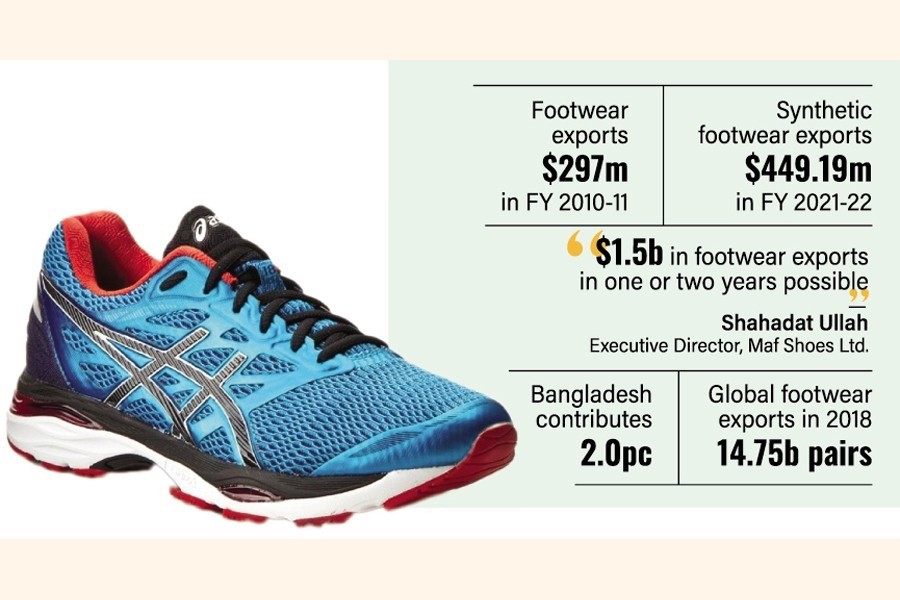China's gradual upgrading from synthetic products to high-tech industries opens a fresh window of export opportunities for Bangladesh's footwear sector, say industry people and experts.
Once the local footwear industry gets a boost, they think it will help diversify the country's export basket and enhance earnings.
Export earnings from footwear items, one of the most common consumer products after garments, could increase threefold within the next couple of years if the sector is provided with the required policy support, they noted.
Locally made synthetic or non-leather footwear exports grew over 30 per cent year on year to US$449.15 million in the fiscal year (FY) 2021-22, buoyed by sports shoes and cases, according to a study finding of Policy Exchange Bangladesh.
Of the $449.15 million worth of export earnings, sports footwear made up the most part of the non-footwear exports with around US$ 200m. About 65 per cent of sports footwear is destined for the European Union.
France, India, Spain, Germany, the Netherlands, Morocco, Turkey, Russia, Poland and the US are the top 10 export destinations, it shows.
The country fetched US$297 million from footwear exports in FY 2010-11, according to official data.
Talking about the trade, Shahadat Ullah, executive director of Maf Shoes Ltd, said Bangladesh has huge potential to increase synthetic-footwear exports as China - the largest exporter of such items - is shifting towards the high-tech industry.
India is one of the biggest consumers of synthetic footwear and would try sourcing from Bangladesh due to China's shifting, he said, adding that it was high time Bangladesh prepared itself to grab the opportunity.
"Bangladesh needs both short-and long-term policy support in this regard," he said, adding that Bangladesh's footwear exports could reach US$1.5 billion within one year or two if provided with required policy assistance.
Dr M Masrur Reaz, chairman and chief executive officer at the Policy Exchange Bangladesh, says the current export scenario denotes overdependence on the RMG sector and its associated risks.
About 81.82 per cent or US$42.61 billion out of US$52.08 billion came from RMG exports in the last FY, he points out.
"Amid the shifting trends in factor efficiencies and global markets, including gradual erosion of low labour-cost advantage and tariff preferences especially after LDC graduation, the overconcentration in few garment items and structural shifts in consumer demands have made diversification critical for Bangladesh," he says.
Citing a Policy Exchange study finding, he said that agribusiness, digital economy and synthetic manufacturing or non-leather footwear have huge potential in diversifying the country's exports and increasing earnings.
Global exports of footwear in 2018 reached 14.75 billion pairs while Bangladesh contributes only 2 per cent of the world's footwear production, ranking the sixth position globally, he notes.
The demand for rubber and plastic footwear rose over the period from 2009 to 2015, occupying export volume at 55 per cent.
China's move into higher value-added products due to high labour costs there as evident from their decreasing share in synthetic manufacturing, and brands looking for diversifying their supply chain have created opportunities for Bangladesh, Mr Reaz thinks.
Lack of skilled workforce, inadequate training programmes, dysfunctional common effluent-treatment plants, access to markets through trade agreements, and global push towards sustainability and compliance are among some major constraints, according to the study findings.
High cost of obtaining certifications, complex border procedures leading to high lead time, lack of stable tax regime and business environment for investment planning are also seen as obstacles to the growth of the sector.
It recommends some policy priorities for building competitive synthetic manufacturing, including facilitating joint ventures in the production of synthetic footwear and chemicals for direct supply to regional production plants to enhance backward linkage.
The study also suggests formulating a long-term strategy for developing the footwear industry with a vision of up to 2041, including providing adequate incentives for investments in the backward linkage of the sector, to propel the growth of the industry, reduce lead time and increase value addition.


